Paella is the ultimate one dish meal! Rice is the star of this versatile dish, which varies according to the cook and region of Spain. Paella can be made with a variety of seafood, meats and/or vegetables. Get comfy, I’m going to tell you everything I’ve learned about paella and teach you how to make paella in your kitchen!

When we lived in Spain for 18 months, we consumed our fair share of paella in restaurants. Most of the paella we ordered were less than memorable. I often asked locals where to find the best paella, and guess what the answer was over and over again? En casa. AT HOME.. I agree!

What is Paella?
While in Spain, we were talking to one of our sons on the phone, and Grant told him I had just made paella. He asked “What is paella?” Grant’s response ” You know, that giant pan with food in it!” I laughed and wrote down the quote, because it was so funny to me, but he was right. Paella is actually the name of the pan, and it is, in fact, filled with food!
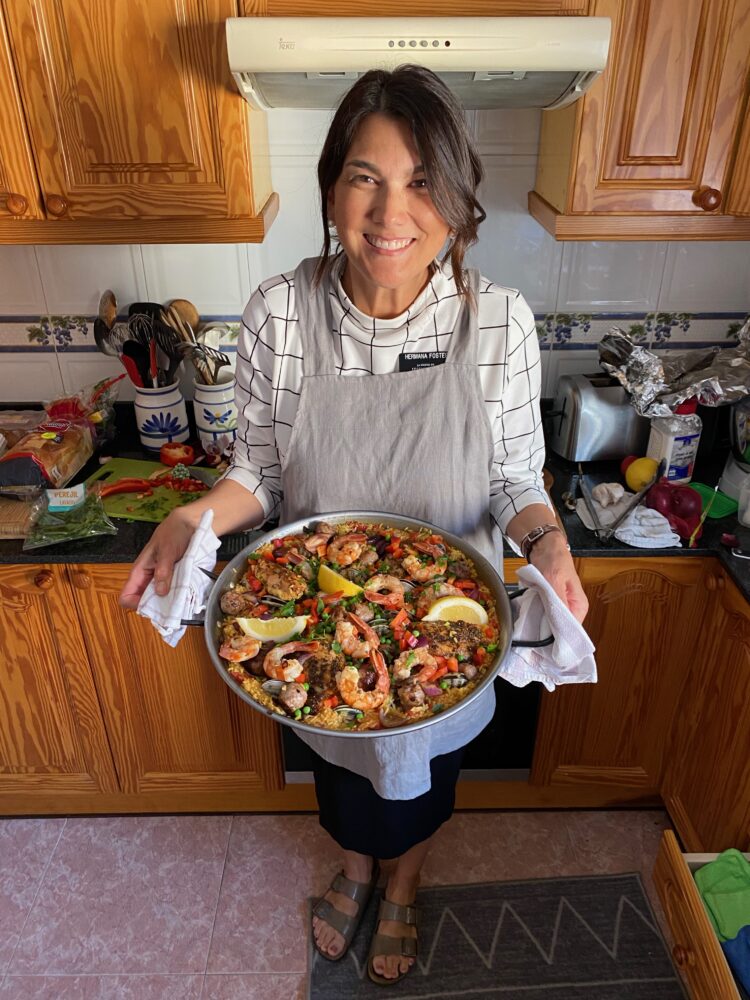
Paella is a dish that consists mainly of rice with a variety of meat, seafood or vegetables, cooked in liquid in a large shallow pan on the stovetop. Paella is the considered to be the national food of Spain. It is usually eaten on special occasions and Sunday, which is a family day in Spain. Most businesses are closed so families and friends can gather to enjoy time together. While we lived in Spain, we often saw families gathering and cooking paella on an outdoor burner, hooked up to a propane tank.

Some people have burners in their kitchens as well. Paella was traditionally cooked on a wood fire outside. Paella is considered to be a meal only served at lunchtime, or medio-dia, because it is too filling to serve in the evening.

Where did paella originate?
Paella originated in Valencia, located about 3 hours south of Barcelona. Valencia is a city, but also a region. Paella was first made by farmworkers in the fields at lunchtime over an open fire. They used rice, which was grown in the region, and anything else available to throw in the pan. In Valencia, snails, rabbit and chicken were plentiful, along with beans. That is why to this day, Valenciana Paella contains those ingredients!

“Paella Valenciana” is what our Spanish amigos refer to as authentic paella. Paella Valenciana needs to have its own post! It is different from the paella I’m sharing today in method and ingredients. Later, I will share a recipe for Paella Valenciana and more about my experience making paella in Valencia!
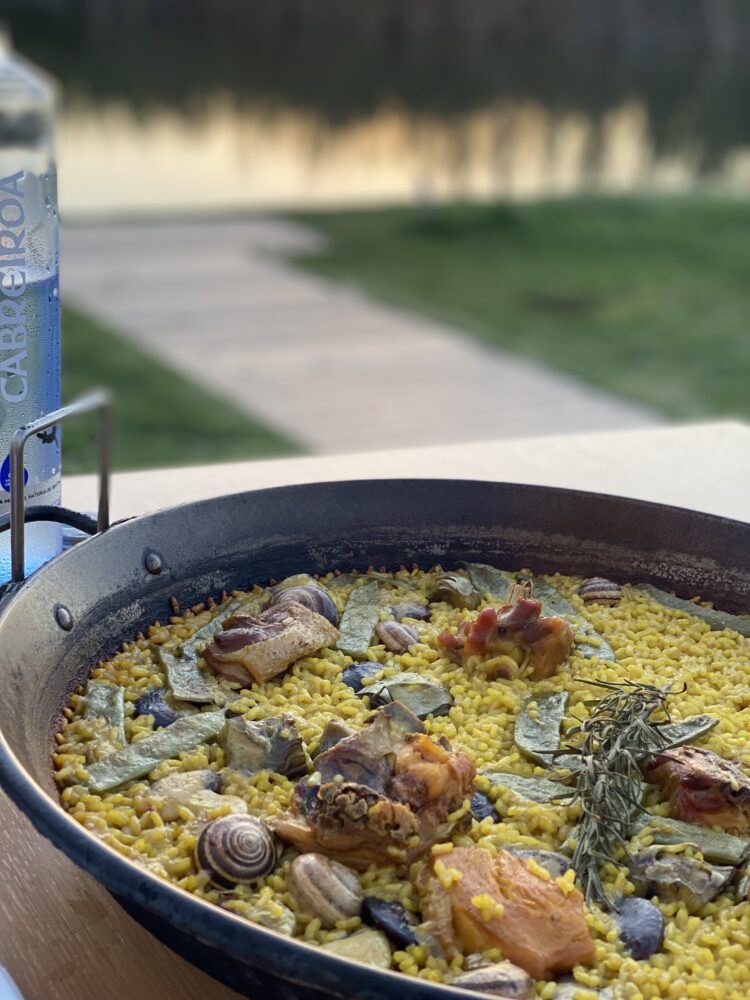
How to navigate this post…
In this post, we will go over the basics of making paella, along with tips from my friend Marga, who was raised in Spain and an incredibly talented cook. Marga taught me how to make paella step-by-step, in her Spanish kitchen. Marga explained the why to each step in our paella making session!
I answer some of the most FAQ I have received when sharing about my experience making paella on Instagram, and also questions I had myself! One warning. Do not be intimidated by the length of the recipe! I broke it down into steps with make-ahead or preparation leading up to the actual cooking of the paella.
Preparation is key to this dish. Cooking is the least labor intensive part of making paella. If you prepare, it is really nothing more than cooking meat and veggies in a pan, cooking rice and then combining the two!
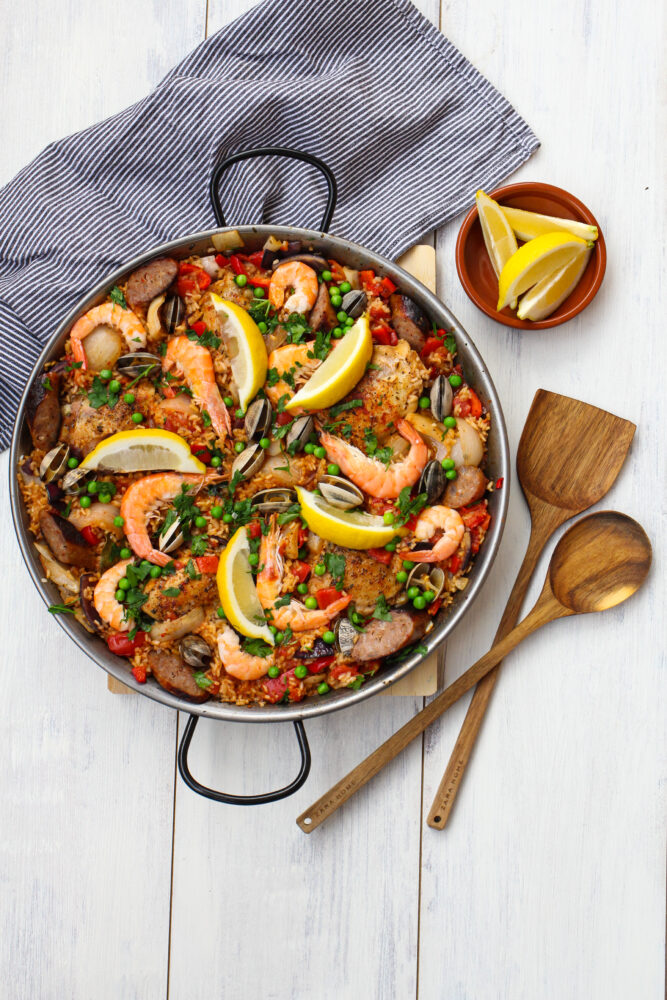
The best recipe for paella?
Asking a native Spaniard about the best paella recipe, is like asking for the best potato salad recipe, or the best chocolate chip cookie or stuffing recipe back home. Everyone has their own twist and (strong) opinion on this popular favorite dish. Tradition also comes into play as well!

Many people native to Spain will say there are ingredients that have no business showing up in paella. Some of those ingredients are: chorizo, onions, tomatoes … It is all a matter of preference. Some say it is not proper to mix land and sea in a paella. Others say when using seafood, stick to either fish or shellfish, and it is ok to mix shellfish with chicken, and or rabbit (yes, rabbit is commonly eaten in Spain). We have found, when dining out in Spain, there are no rules as far as paella goes. Where paella is served, anything goes!
If you do have the good fortune to visit Spain, be careful about where you eat paella. Many of the restaurants in Spain cater to tourists who are anxious to try this traditional Spanish dish. Unfortunately, some restaurants buy paella frozen and then place it in a pan, heat it up and toss on a few pieces of seafood or vegetables on top. Do your research before choosing a restaurant!
You can also look carefully at the set up in the kitchen. If they only have room for a microwave and there are no stoves in site, your food is most likely being purchased frozen. Look for reputable restaurants that cook from scratch before spending your hard earned money.

Michelin Chef tips for making paella (Marga’s secret recipe)
Marga has been making paella for years. She learned a few tips for making paella from a Michelin chef that she passed along to me. The first is add crushed toasted nuts. I had never heard or seen this done previously, but I can tell you this. Marga’s paella remains my all-time favorite! The nuts give a slightly earthy flavor to the paella. They are not overpowering and they also help to thicken the liquid a bit.
Second tip, toast the saffron before adding to the broth. Marga places the threads of saffron in the microwave for 10 seconds on a plate before crushing with her fingers. Just enough time to toast the threads and help to release the flavor.
Third tip, make Sofrito and use it in the base of the paella. Sofrito is a mixture of tomatoes, onion, garlic and salt cooked in olive oil over a slow flame. Some Spanish recipes for Sofrito include parsley, red peppers, paprika, or other peppers. Marga uses a simple base, slow cooked, and then blended together until smooth. I love her version and highly recommend making a batch to keep on hand in your fridge or freezer!

Last Michelin chef tip: Bring the broth to a boil, remove one cup of broth. Add the toasted threads of saffron to the cup of broth, along with 2 tablespoons of full strength (not reduced sodium) soy sauce. Marga uses half fish stock and half chicken stock in her paella. Since fish stock varies all over the board from excellent-to-awful, I recommend using chicken stock in this recipe. If you are making a seafood paella, and would like more fish flavor, you may also use part bottled clam juice.
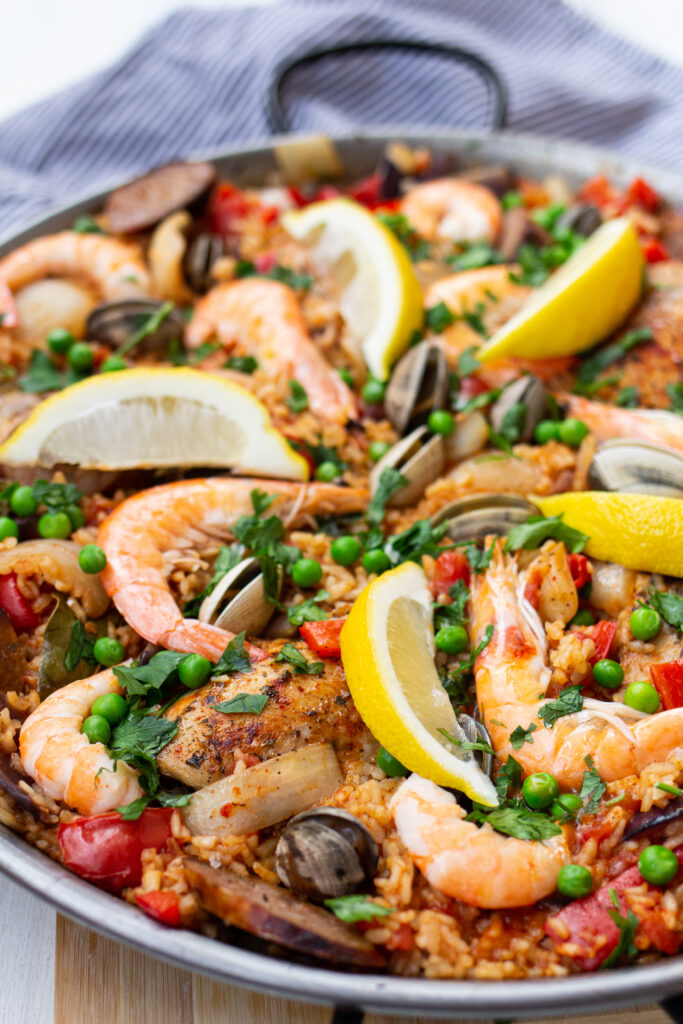
Don’t make these beginner mistakes…
More is not better. When I first started making paella, I added a whole container of saffron threads (which should have covered 4-5 paella) to one pan. I didn’t necessarily think more was better, I just didn’t look carefully at the package to see a few threads were enough!
It is also tempting to add more rice than called for in this recipe. Remember, Bomba rice is specially grown to absorb 2-3 times its weight and will swell considerably while cooking. The rice should not be thicker than “a finger” in the bottom of the pan. Which means about 1/2 to one inch thick at most.
If you add too much rice, it will require more liquid to cook properly and the flavors in the dish will diminish and get lost in excess rice. As a rule of thumb, allow 1/2 cup (uncooked) or 100 grams of rice per person. If the amount of people increase, the size of the pan also needs to increase for the rice to cook properly. You may also use an additional pan if needed! I use a 16-18 inch pan for this recipe. See FAQ below for more info on pans.

What is Socarrat and why is it important?
If you have read more than one article or watched a cooking demonstration on paella, you have heard the word socarrat. It is the crispy, caramelized layer of rice on the bottom of the paella. After the rice is completely done cooking, and all of the liquid has been absorbed, the paella is left on the flame or heat for a few minutes until the rice begins to make a crackling sound (Marga had me put my ear to the pan to listen for the sound). This is the rice being crisped on the very bottom layer and the most desired part of the paella!
If possible, it is best to stay away from using a non-stick skillet when making paella because the socarrat is more difficult to develop. Cast iron is also not recommended because it retains too much heat for proper cooking of this dish. That said, if you really want to make paella, and you only have non-stick, this recipe will work, but don’t wait too long for the Socarrat to form!
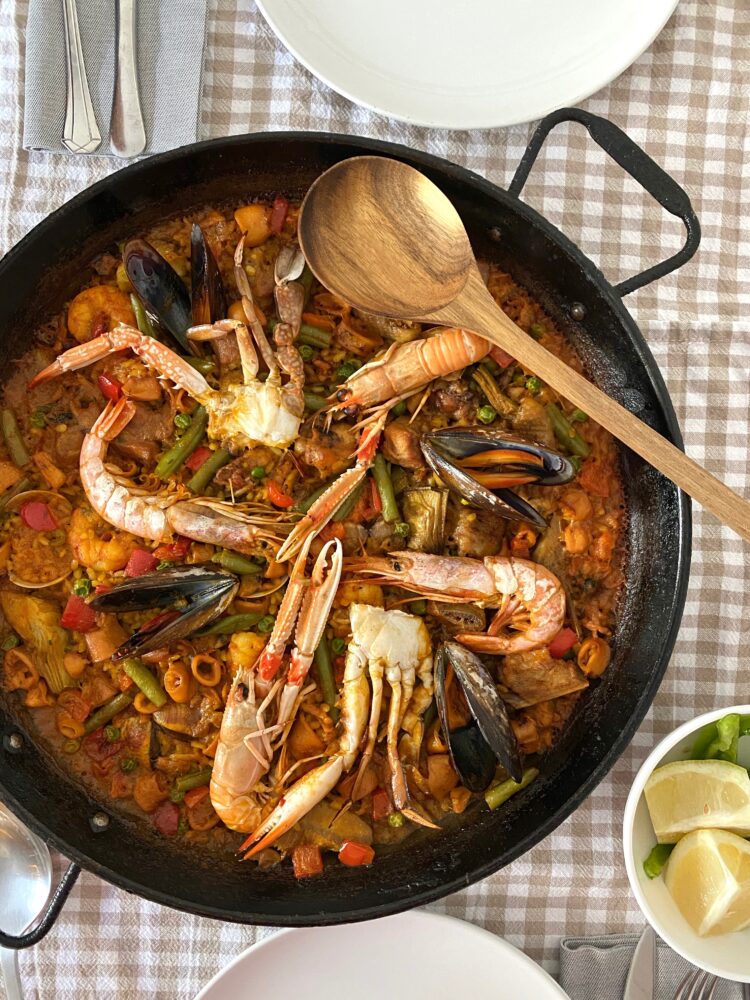
Steps for making Paella:
- Marinate the meat or seafood.
- Prepare sofrito.
- Toast and crush the nuts.
- Cut up the vegetables, if using artichokes, place in lemon water.
- Toast the saffron, place in heated stock. Add soy sauce to stock.
- Heat the pan, add oil and meat. Remove meat from pan.
- Add additional oil to the pan along, with vegetables. Cook for a few minutes.
- Add sofrito, rice, stock, saffron and soy sauce. Cook for 10 minutes.
- Add meat back to pan, finish cooking. Remove from heat, cover with towel.
- Let sit for 5-10 minutes, garnish with additional parsley and lemon slices.

FAQ and tips for making paella:
Note: there are some affiliate links included in this section of the post, which means I receive a small commission on items purchased thru Amazon. You can also find ingredients in specialty grocery stores.
- Number one tip: Read this section before making paella. Read the entire recipe and gather all ingredients before starting to cook!
- Do I need to use a special pan? Paella is made in a round, flat bottom pan, usually about 2 inches deep and varying in diameter. You may also use a 12 inch skillet (or two) that is NOT non-stick to feed up to 4 people. Non-stick and cast iron are not recommended. See section about the socarrat regarding importance of type of pan.
- What size pan should I use to make paella? I have both 16 and 18 inch pans. A 16 inch pan will feed 4-6 people, and a 18 inch pan will feed 8-12 people. I (most often) use a 16 inch pan for this recipe. If you are not using a traditional paella pan, I recommend splitting this recipe into two 10-12 inch skillets.
- What is the best type of rice to use in paella? Bomba rice is the rice of choice in paella. It is found everywhere in Spain, but more difficult to find in the US. Bomba rice is a short grain rice which is best because it retains liquid and flavors well. In the US, Bomba rice is found on Amazon or you may use Aborio rice or Japanese Sushi rice (such as Cal Rose), which are found in most grocery stores. Do not use long grain, Basmati or instant rice in paella!
- Can I cook paella in the oven? Yes, while living in Spain, I had an induction stove, which made it very difficult to cook the entire pan at one time. I rotated the pan until I cooked the paella most of the way thru, then transferred it to a hot oven and back to the stovetop to finish crisping the bottom. Once you get the hang of making paella, you will be able to transfer it to the oven to cook partially if you have an issue with the burner not being large enough.
- What makes the rice yellow or gold in paella? The rice is white when first added to the paella. The spices including saffron and paprika turn the dish yellow or a golden tone. Most cooks in Spain use a colorant as well. It is sold in every Spanish grocery store, is very inexpensive and is bright yellow or orange in color. I do not use the colorant in my recipe.
- What type of paprika is used in paella? Spanish paprika or Pimentón is used in most Spanish recipes. Most Spanish grocery stores carry Pimentón dulce (sweet) or Pimentón picante (spicy). It is important to use Spanish paprika instead of Hungarian paprika when cooking Spanish dishes. Spanish Pimentón is smoked and has a distinct flavor! Most people prefer a more mild flavor when making paella and use Pimentón dulce.
- What is a good substitute for saffron? Saffron is quite expensive, but the good news is you only need a few threads in a large paella. Be careful to not overload your dish with saffron, a little goes a long way! Good substitutes for saffron threads include: a teaspoon of smoked paprika (Pimentón dulce) plus 1/4 teaspoon of turmeric for flavor and color. Trader Joes sells saffron as well as most grocery stores in the US.
- How thick should the layer of rice be in the paella? This question has a very clear answer, although many cooks ignore Spanish custom! The rice should be 1/2 inch to (no more than) one inch thick after cooking. If it is thicker than this, the rice has little chance of forming the desired crispy bottom with the remaining rice being cooked properly.
- Should I stir the rice when making paella? Do not stir the rice. This is probably the number one rule when making paella that all cooks agree on. It is ok to gently move ingredients around when you are initially placing the rice, veggies and meat in the pan, but once the rice is evenly distributed and cooking, there should be no stirring taking place. If you stir the rice, you will have a few problems: the rice will become mushy and pasty and it will not have a chance to develop the coveted socarrat (see explanation earlier in post).
- What should I do if my rice is not cooked and all of the liquid is absorbed? Leave the rice on medium heat and add the additional cup of stock. If more liquid is needed, add a few tablespoons of water at a time until the rice is cooked.

Every recipe for paella varies and you will have your own likes and dislikes according to your taste. Some people like their paella to be a little more on the saucy side, others like it more dry. We love seafood, so I make seafood paella most often. It is equally delicious made with chicken. The altitude and humidity will play into how long the rice needs to cook. I hope you will give this recipe a try and give me your feedback. We love this new tradition of making paella and hope it will extend for generations to come in our family!

How to Make Paella

Ingredients
Meat and Marinade:
- 2 1/2 lbs chicken thighs*, seafood (large shrimp, uncooked, small clams, mussels, cut up fish) or a combination of meat and seafood, washed and cut up
- 3 tablespoons olive oil (more needed while cooking meat)
- 2 cloves garlic, chopped
- 1 tablespoon dry oregano leaves
- 1 tablespoon Pimenton (Spanish smoked paprika), Spanish pimiento dulce see FAQ section
- 1 teaspoon salt
Sofrito:
- 2 tablespoons olive oil
- 2-3 cloves garlic (about 4 teaspoons) chopped
- 2-3 tomatoes, about 2 cups chopped tomatoes OR one 14-16 oz can peeled tomatoes whole or chopped, drained before using
- 1 1/2 cups sweet onion (such as Vidalia, Walla Walla)or white onion, chopped
- 1-2 teaspoons sea salt, or to taste
Vegetables and (optional) toasted nuts and garnish:
- 3 cups chopped vegetables such as: red pepper, fresh green beans, artichokes, mushrooms, small red onion, peas
- ½ cup green onion, chopped
- 1/2 cup fresh parsley, chopped and divided
- 2 tablespoons almonds or hazelnuts toasted and ground until consistency of flour (a few small chunks are ok), optional
- 1-2 fresh lemons, cut up
Saffron, Liquid and Rice:
- 3-5 threads saffron for 6 person paella, about ¼ teaspoon of threads loosely packed
- 5-6 cups chicken stock
- 2 tablespoons soy sauce
- 2 cups Spanish Bomba rice, see substitutions on post under FAQ
Instructions
Prepare the meat/seafood:
- Up to one day before making paella, mix 3 tablespoons of olive oil, minced garlic, oregano, pimenton and salt together in a bowl. Place the meat or shrimp into a gallon size ziplock bag or in a glass dish and mix well so all surfaces of the meat are covered with spice mixture. Refrigerate until ready to cook. See notes if using frozen seafood.
Prepare the sofrito:
- Place pan on stove, turn heat to medium. Add 2 tablespoons olive oil and garlic and let cook for about one minute. Add chopped tomatoes, onion and 1 teaspoon sea salt. Cook on medium low heat until the mixture is completely softened, about 30-45 minutes. Taste to see if more salt is needed. Let cool. Using an immersion blender, blend until smooth or leave chunky.
Prepare the nuts (optional but highly recommended):
- Place the almonds or hazlenuts on a baking sheet and heat the oven to 350 degrees. Bake for about 5-8 minutes or just unil the nuts start to change color and darken. Remove and let cool for a few minutes. Crush the nuts until they are the consistency of flour (it is ok if there are a few small pieces) using a mortar and pestle or a food processor. Place the crushed nuts in a bag or other air tight container.
Prepare the vegetables:
- Wash and chop the vegetables, set aside or refrigerate overnight. If using canned artichoke hearts, drain well and squeeze one fresh lemon over the canned artichoke hearts in a bowl, set aside until ready to cook (if using fresh see recipe notes). Wash and cut lemons into wedges for serving. Set aside.
Prepare the stock and saffron:
- Place the saffron threads on a small plate and microwave for 10 seconds. Remove from microwave. Heat 6 cups of chicken and/or a combination of chicken and clam juice to a pan and bring to a boil. Turn off and remove from heat. Crush the toasted saffron threads into the stock and add 2 tablespoons of soy sauce to the stock as well. Set aside until ready to make paella.
Begin cooking paella (finally!)
- Place a 16 inch paella or two 10-12 inch skillets over medium high heat. Add 2 tablespoons olive oil to pan. Add the meat and/or shrimp to the pan. Cook chicken for about 6 minutes per side or until almost done. If cooking shrimp, cook for about 2 -3 mintues per side. Remove to a plate, cover and set aside.
- Add artichokes that have been drained. If fresh artichokes, cook for about 6-8 minutes, turning once every few minutes. Salt the artichokes generously. If using canned, cook for about 3-5 minutes total. If you would like to decorate the top of the paella with red pepper strips, add those to the pan with the artichokes and cook just until the red pepper barely begins to soften. Remove the red pepper strips and set aside on a plate. Leave the cooked artichokes in the pan. Add any additional vegetables- chopped red pepper, zucchini, fresh green beans, slices of red onion, mushrooms, etc. to the pan and cook for about 2-3 minutes. Add salt to the vegetables, cook until softened and browned just a bit. You may need to add an additional tablespoon or two of olive oil to the pan while vegetables are cooking.
- Add the prepared sofrito (about 1 cup) to the pan over medium high heat and cook for about 1-2 minutes until bubbly. Add 2 cups Bomba rice, 1/4 cup parsley, chopped green onion and mix with the sofrito and vegetables in the pan. Use a spatula to loosen some bits on bottom of pan and mix into rice.
- Add the stock mixed with saffron and soy sauce to the pan. Sprinkle the prepared toasted and crushed nuts onto the paella evenly.
- Add meat (if using chicken) back to the pan at this time. If using shrimp, wait until later to avoid overcooking.
- Gently spread out the meat and vegetables evenly with the rice and broth. Do not stir. The mixture should look very soupy at this time and have an even boil all over the pan. Do not ever cover the paella while cooking!
- Cook for about 5 minutes on high heat. Turn heat to medium high after 5 minutes. At the 10-12 minute mark, the rice should be visible, and much (about 3/4) of the liquid should be absorbed. If you are cooking on a stovetop and the pan is too large for the burner, turn the pan occasionally or straddle over two to three burners. Alternately, you may heat your oven to 375-400 degrees and carefully place the paella inside of the oven with the door cracked. Make sure your pan has oven proof handles if using this method.
- The paella is about 5-10 minutes from being done. At this point, turn the heat to medium. The liquid should still be boiling. Add the shrimp and seafood to the paella now, placing the shrimp on top of the rice and nestle clams into the rice gently. The clams should open when heated through. Any unopened clams should be discarded. Continue to cook until the liquid is absorbed. If the rice is not cooked enough and the liquid is all absorbed, drizzle some additional liquid (water or more stock) over the paella and continue to cook for a few minutes. Sprinkle with additional 1/4 cup chopped parsley or peas.
- Remove from heat when rice is done. Cover with a clean kitchen towel and let paella rest for 5-10 minutes. Garnish with lemon slices, a bit of parsley and cooked red pepper slices. Serve paella on the table with lemon slices, sliced baguette and a green salad.
Notes
- Bomba Rice is my #1 choice. If you can’t find it in the US, I have used Cal Rose (Japanese) rice with success in this recipe.
- I highly recommend using in-bone chicken thighs in this recipe instead of white breast meat. Thighs may be cooked with skin on or removed. If the thighs are large(bigger than your fist), use a sharp knife and cut in half.
- Notes for Sofrito: Store in refrigerator for up to one week, or in freezer for up to 6 months. Yields about 1 cup of prepared sofrito. This recipe uses about 1 cup of sofrito. I highly recommend making a double batch and freezing or refrigerating the rest for use in other recipes, or to top eggs, eat on toast etc.
- Frozen or fresh shrimp may be used, as well as small clams or mussels. If using frozen seafood, remove from freezer and let thaw in refrigerator for 12-24 hours before cooking, drain and then let sit in spice marinade for 2 hours. If using fresh seafood, wash, pat dry and place in marinade overnight. It is not absolutely necessary to marinate the meat/seafood in the spice mixture overnight, you can also toss with the marinade ingredients and let sit while prepping other ingredients for paella just before cooking. Make sure to scrub the shells under cold running water to remove sand. I do this at least twice before using in paella. Once I forgot (just rinsed quickly) and ended up with sandy, inedible paella!
- If using artichokes, you may use canned or fresh artichoke hearts. If using fresh, trim the top 1/2 and bottom off of artichoke. Cut the artichoke in half and scoop out the hairy “choke” in center and discard. Cut artichoke into quarters and then again into half. You should have 8 pieces. The artichoke will begin to turn brown quickly, which is fine it will not harm the flavor of the paella. Place the trimmed artichoke into a bowl with about 3-4 cups water and juice from one lemon and the squeezed lemon halves. Set aside until ready to use. This can be done the night before and refrigerated, covered or about 1-4 hours before serving and left sitting on countertop. Before using fresh artichokes, squeeze the lemon water out of the artichoke leaves over the sink.
- Vegetarian paella may be made by using vegetable stock instead of chicken stock and chickpeas or additional vegetables in place of the meat and seafood.
- When making paella using shrimp, I usually do not add the red pepper strips on top. Marga told me the red pepper strips were called “poor man’s paella” for those who could not afford to buy seafood long ago, which gave red color to the finished paella!
- The crushed nuts may also be stored in freezer for several months until ready to use.
- Do not ever cover the rice while cooking! It is fine to cover the dish with a clean kitchen towel after cooked to rest, or loosely with a piece of foil.
- I love to serve paella with fresh lemon slices on top of the paella as well as a bowl of cut lemon on the side to squeeze over each serving.
- If you don’t want to cook the slices of red pepper, it is fine to just slice and place on top of the paella, but most Spaniards cook the red pepper before using as a garnish!
Equipment
- One 16" paella pan, or another shallow pan with a wide bottom. If you are using a skillet, I recommend splitting the recipe between TWO 9-12 inch skillets and cooking at the same time.
Did you make this recipe?
Be sure to leave a comment and give this recipe a rating, letting me know how you liked it. I’d love to see a photo, tag @abountifulkitchen on Instagram!
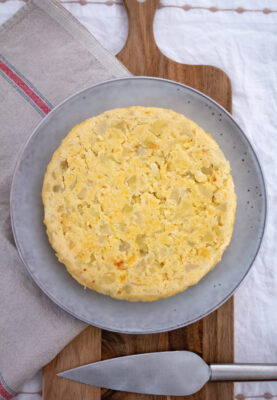

Jan
This summer my family and I got the opportunity to visit Spain and was able to reserve a spot at Casa Carmela in Valencia. We had reserved the Paella Valenciana and it was amazing! When I got home I wanted to emulate what I had in Spain and stumbled on your recipe. Today I finally got a chance to make this for family and friends and it came out amazing! I ended up putting my 16 inch paella in a grill since I don’t have a burner and it worked perfectly! We are forever changed! Would love to send photos if you would like me to share! Thank you!
Emily white
My husband served in Madrid Spain and I have yet to make an authentic paella for him! Are you using whole almonds, sliced almonds, or slivered almonds? Thanks!
Si Foster
Hi Emily,
You will love this recipe! I use whole almonds for this recipe.
Si
Katie
This is the next recipe I intend to try from my copy of the ABK cookbook.
Sumer
I made this dish just last night and it turned out wonderful! Thank you for a paella recipe that is delicious and easy to make!
Si Foster
Sumer, I am so that that this recipe turned out wonderful for you! Thanks for reading ABK!
Xo
Si
G Dra
Hello, this recipe looks great. I will attempt it for Christmas dinner. Good luck to me 😳 I have a question. I don’t have anything that will grind the nuts into a fine consistency, Can I use almond meal/flour?
Si Foster
Hey there Garret, I haven’t ever tried to replace the nuts with almond or meal flour. You do have the option to leave the nuts out. Let me know how it turns out! Thanks for reading ABK!
Happy Holidays,
Si
Tanvir Ahmed
Paella has always been my favorite. And my Mom makes it once a week. I’m coming here to learn this recipe to surprise Mom next week. I read this recipe thoroughly and realized that it is not so difficult to make. I really like this recipe.
Ann
My family and I love this dish so much! I have made it several times and will continue to make it on a regular basis. It is a fun recipe and has built my confidence in the kitchen as my family really thinks I have accomplished something special. I agree with other comments that it is not hard, just a little more time consuming. If you prep in the morning, doing as many steps as possible then it comes together quickly at dinner time. I ordered the bomba rice from amazon, and it wasn’t a big deal. I also love how versatile it is as it is good with kielbasa, chicken or shrimp or all three!
Si Foster
Hi Ann,
Thanks for your feedback, especially since you have made this paella several times! I agree, making a paella is an accomplishment, but worth the extra time and effort. Thanks for your tips as well!
XO
Si
Becky
I don’t remember ever having paella before, although we are foodies who love to try restaurants and recipes. I saw this on your IG and had to try it, and it was AS AMAZING as it looked. Which is saying something! So flavorful. Tips for others: I could only find arborio rice (although I didn’t search too hard) but I thought it was great. When I make it again I will likely try to do some in advance (day before!), It was a LOT of work in one sitting although deliciously worth it!! I would do the chicken marinade, sofrito, vegetable chopping, nut grinding . . Then just be able to put it all together the day of. Thanks as always for another great meal!!
Si Foster
Thanks Becky. I completely agree, make ahead and preparation are key to making this recipe easy! So glad you loved it and thank you so much for leaving feedback!
XO
Si
Jan
This summer my family and I got the opportunity to visit Spain and was able to reserve a spot at Casa Carmela in Valencia. We had reserved the Paella Valenciana and it was amazing! When I got home I wanted to emulate what I had in Spain and stumbled on your recipe. Today I finally got a chance to make this for family and friends and it came out amazing! I ended up putting my 16 inch paella in a grill since I don’t have a burner and it worked perfectly! We are forever changed! Would love to send photos if you would like me to share! Thank you!
Si Foster
Jan! This makes me so happy. I am glad that you and your family enjoyed this recipe & that you were able to give them a taste of Spain. Would love to see photos! Either send to the A Bountiful Kitchen Instagram or Facebook account. Thanks for your positive feedback.
XO
Si
Donna Christensen
OH MY STARS!! Thank you so much for sharing this post with us!! Thank you, Thank you for all the tips and tricks! We have visited Spain several times and LOVE this delicious meal; my son also served a mission there! I can’t wait to make it AGAIN for him! It was so YUMMY! I was able to get all the right ingredients and follow you as I prepared, thank you! You made me feel comfortable and confident as I cooked and it turned out perfect! So delicious! Thank you for sharing your talents, skills and love of Spain with us!
Si Foster
You are so very welcome Donna! Im so happy to hear you loved this recipe and it was a success for you! Isn’t it fun to make a meal your family loves especially when there is a sentimental connection?!
xo
Si
Ann
This was delicious! I make paella every few months as our family loves it and they said this was the best I have ever made. I used the Bomba rice, shrimp and chicken thighs as some in my family won’t eat shrimp and others won’t eat chicken. We were all happy. It was more work than most of my dinners and I made it all in one day, but nothing was hard or difficult. Thank you Si for sharing your authentic recipe and methods!
Si Foster
Hi Ann,
Thank you so much for sharing your review! So glad your family loved this recipe. I agree it takes a bit of time, but really quite easy to make this recipe! Thanks for reading ABK,
XO
Si
Emmy
Like you, I fell in love with Paella in Spain and quickly discovered not everyone/restaurant does it well. It becomes an obsessed search for great Paella, so you have to learn to make it. Your descriptions and instructions are perfect! I know you will inspire many!!
Si Foster
Thank you Emmy! It is hard to beat good paella! I’m glad you found the instructions to be helpful 🙂
Thanks for reading ABK,
XO
Si